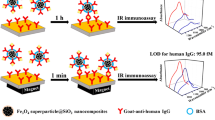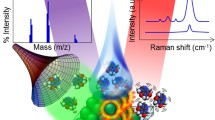Abstract
Silica nanorods were synthesized through a simple one-pot emulsion-droplet-based growth method, in which tetraethylorthosilicate (TEOS) was used as the silica source, ammonia as the catalyst, and polyvinylpyrrolidone (PVP) as the structure-directing agent and stabilizer. By controlling hydrolysis and condensation in the reaction process, we regulated the aspect ratios and the infrared (IR) absorption fingerprint signals (the transverse optical and the longitudinal optical phonon modes) of the silica nanorods. Based on this, a dual-mode immunoassay was performed for detecting model target analyte, human IgG. The shape code of the silica nanorods was used for simple, rapid qualitative, and sensitive semi-quantitative immunoassay by using a conventional optical microscope. The characteristic IR absorption fingerprint signals of the silica nanorods allowed for reliable quantitative immunoassay with good selectivity and high specificity. The detection limit and the linear range were found out to be 0.5 pM and 1 pM–10 nM, respectively. We expect that such dual-mode immunoassay could be applied for the detection of other analytes, such as protein, nucleic acids, bacteria, viruses, explosives, toxins, and so on.

A simple dual-mode immunoassay was performed using the shape code and infrared absorption fingerprint signals of silica nanorods as detection signals.






Similar content being viewed by others
References
Zhang Y, Qian J, Wang D, Wang Y, He S. Multifunctional gold nanorods with ultrahigh stability and tunability for in vivo fluorescence imaging, SERS detection, and photodynamic therapy. Angew Chem. 2013;52(4):1148–51.
Olutas M, Guzelturk B, Kelestemur Y, Gungor K, Demir HV. Highly efficient nonradiative energy transfer from colloidal semiconductor quantum dots to wells for sensitive noncontact temperature probing. Adv Funct Mater. 2016;26(17):2891–9.
Zhang F, Shi Q, Zhang Y, Shi Y, Ding K, Zhao D. Fluorescence upconversion microbarcodes for multiplexed biological detection: nucleic acid encoding. Adv Mater. 2011;23(33):3775–9.
Kilinc D, Dennis CL, Lee GU. Bio-nano-magnetic materials for localized mechanochemical stimulation of cell growth and death. Adv Mater. 2016;28(27):5672–80.
Tarn D, Ashley CE, Xue M, Carnes EC, Zink JI, Brinker CJ. Mesoporous silica nanoparticle nanocarriers: biofunctionality and biocompatibility. Accounts Chem Res. 2013;46(3):792–801.
Chen Y, Chen H, Shi J. In vivo bio-safety evaluations and diagnostic/therapeutic applications of chemically designed mesoporous silica nanoparticles. Adv Mater. 2013;25(23):3144–76.
Guerrero-Martinez A, Perez-Juste J, Liz-Marzan LM. Recent progress on silica coating of nanoparticles and related nanomaterials. Adv Mater. 2010;22(11):1182–95.
Ding Y, Chu X, Hong X, Zou P, Liu Y. The infrared fingerprint signals of silica nanoparticles and its application in immunoassay. Appl Phys Lett. 2012;100(1):013701–3.
Chauhan VP, Popovic Z, Chen O, Cui J, Fukumura D, Bawendi MG. Fluorescent nanorods and nanospheres for real-time in vivo probing of nanoparticle shape-dependent tumor penetration. Angew Chem. 2011;50(48):11417–20.
Tsai CP, Hung Y, Chou YH, Huang DM, Hsiao JK, Chang C. High-contrast paramagnetic fluorescent mesoporous silica nanorods as a multifunctional cell-imaging probe. Small. 2008;4(2):186–91.
He B, Son SJ, Lee SB. Shape-coded silica nanotubes for biosensing. Langmuir. 2006;22(20):8263–5.
He B, Son SJ, Lee SB. Suspension array with shape-coded silica nanotubes for multiplexed immunoassays. Anal Chem. 2007;79(14):5257–63.
He B, Kim SK, Son SJ, Lee SB. Shape-coded silica nanotubes for multiplexed bioassay: rapid and reliable magnetic decoding protocols. Nanomedicine. 2010;5(1):77–88.
Wu SH, Mou CY, Lin HP. Synthesis of mesoporous silica nanoparticles. Chem Soc Rev. 2013;42(9):3862–75.
Sun B, Zhou G, Zhang H. Synthesis, functionalization, and applications of morphology-controllable silica-based nanostructures: a review. Prog Solid State Chem. 2016;44(1):1–19.
Hu Q, Suzuki H, Gao H, Araki H, Yang W, Noda T. High-frequency FTIR absorption of SiO2/Si nanowires. Chem Phys Lett. 2003;378(3–4):299–304.
Martínez IM, Ruiz F, Vorobiev YV, Pérez-Robles F, González-Hernández J. Infrared spectroscopy analysis of the local atomic structure in silica prepared by sol-gel. J Chem Phys. 1998;109(17):7511–4.
Al-Oweini R, El-Rassy H. Synthesis and characterization by FTIR spectroscopy of silica aerogels prepared using several Si(OR)4 and R′′Si(OR′)3 precursors. J Mol Struct. 2009;919(1–3):140–5.
Fidalgo A, Ilharco LM. Chemical tailoring of porous silica xerogels: local structure by vibrational spectroscopy. Chem Eur J. 2004;10(2):392–8.
Roy Chowdhuri A, Jin D-U, Takoudis CG. SiO2/Si(100) interface characterization using infrared spectroscopy: estimation of substoichiometry and strain. Thin Solid Films. 2004;457(2):402–5.
Kahler U, Hofmeister H. Silicon nanocrystallites in buried SiOx layers via direct wafer bonding. Appl Phys Lett. 1999;75(5):641–3.
Wang S, Chen Z, Choo J, Chen L. Naked-eye sensitive ELISA-like assay based on gold-enhanced peroxidase-like immunogold activity. Anal Bioanal Chem. 2016;408(4):1015–22.
Qin G, Zhao S, Huang Y, Jiang J, Ye F. Magnetic bead-sensing-platform-based chemiluminescence resonance energy transfer and its immunoassay application. Anal Chem. 2012;84(6):2708–12.
Acknowledgements
This work was supported by the National Natural Science Foundation of China (Grant Nos. 51272040, 11604043, and 51372096), the 111 project (No. B13013), and Program for New Century Excellent Talents in University of Ministry of Education of China (Grant No. NCET-12-0815).
Author information
Authors and Affiliations
Corresponding authors
Ethics declarations
Conflict of interest
The authors declare that they have no conflict of interest.
Electronic supplementary material
ESM. 1
(PDF 398 kb)
Rights and permissions
About this article
Cite this article
Zhao, P., Ni, R., Wang, K. et al. Dual-mode immunoassay based on shape code and infrared absorption fingerprint signals of silica nanorods. Anal Bioanal Chem 409, 4207–4213 (2017). https://doi.org/10.1007/s00216-017-0369-8
Received:
Revised:
Accepted:
Published:
Issue Date:
DOI: https://doi.org/10.1007/s00216-017-0369-8




